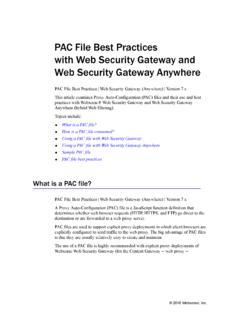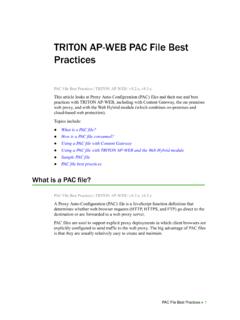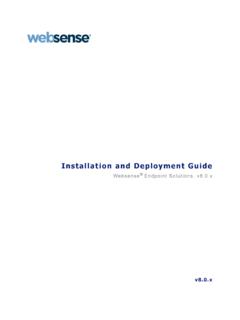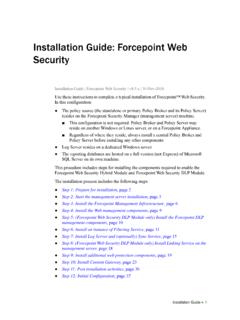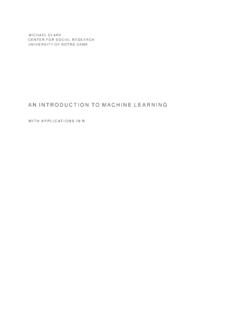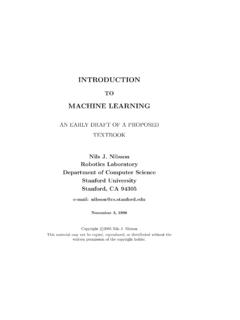Transcription of Introduction to machine learning - Forcepoint
1 2014 Websense, to machine learning for Websense Data SecurityTopic 65022 | machine learning | Data Security Solutions | Updated: 31-Oct-2012 machine learning is a branch of artificial intelligence, comprising algorithms and techniques that allow computers to learn from examples instead of pre-defined rules. As a user of Websense Data Security, you can provide examples that train the machine learning system to help protect your organization s information. After training, the system creates a classifier that classifies documents based on how similar they are to your examples. machine learning offers advantages and disadvantages compared with other Websense data classification methods.
2 It is important to assess whether machine learning is the best solution for your particular circumstances. This article offers a general Introduction and looks at the types of data that can be effectively protected using machine learning . machine learning basics Knowing when to use machine learning How Websense machine learning works Selecting examples for training What happens during training Accuracy of machine learning Using the classifier Tuning the classifiers Comparison with other types of classifiersFor more information on how to use machine learning , see the following: Data Security Manager Help Using machine learning for Optimal Data Loss Prevention (video)Applies to:Data Security, and to machine learning 2 machine learning basicsTopic 65023 | machine learning | Data Security Solutions | Updated.
3 31-Oct-2012 There are two main types of machine learning algorithms: Supervised learning algorithmsThe algorithms are given labeled examples for the various types of data that need to be learned. Unsupervised learning algorithmsData is unlabeled and the algorithms attempt to find patterns within the data or to cluster the data into groups or sets. Websense machine learning uses both types of algorithms. Knowing when to use machine learningTopic 65024 | machine learning | Data Security Solutions | Updated: 31-Oct-2012 Websense machine learning , like any other decision systems that need to handle complicated data, may generate false positives (unintended matches) and false negatives (undetected matches).
4 The total fraction of false positives and false negatives is sometimes referred to as the accuracy of the system. Since the accuracy of machine learning is derived from the properties of the data and finding the best data sets can sometimes be challenging, you may want to first determine if other types of classifiers, such as fingerprinting or pre-defined policies, can help you classify and protect your data before considering using machine use case in which machine learning could be effective is if you need to differentiate between proprietary and non-proprietary data, like you might find in source code.
5 It may be hard to fingerprint source code that is under constant development and continually changing, and pre-defined policies cannot distinguish between proprietary and non-proprietary source provides several pre-defined content types that address some common use cases, including source code (in C, C++, Java, Perl, and F#), patents, software design documents, and documents related to financial investments. If you need to protect content that belongs to these content types, consider using machine learning , and select the content type that is pre-defined by the Websense system. machine learning can also be used to complement and enhance fingerprinting and pre-defined policies and other Data Security detection and classification methods.
6 Applies to:Data Security, and to:Data Security, and to machine learning 3 How Websense machine learning worksTopic 65025 | machine learning | Data Security Solutions | Updated: 31-Oct-2012 Supervised machine learning for data protection requires, in general, two types of examples: content that needs to be protected and counterexamples. The former is usually referred to as positive and the latter as negative. Counterexamples are documents that are thematically related to the positive set yet are not meant to be protected, such as public patents versus drafts of patent applications, or non-proprietary source code versus proprietary source code.
7 However, since it can be difficult and quite labor intensive to find a sufficient number of documents for the negative set (which includes ensuring that no positive examples are inside this set), Websense has developed methods that allow the system to use a generic ensemble of documents as counterexamples to the positive set. (See Negative examples consisting of All documents examples, page 4 and Positive examples, page 4).For text-based data, some of the algorithms automatically create an optimal weighted dictionary that assigns positive weights to terms and phrases that are more likely to be included in the positive set and negative weights to terms and phrases that are more likely to be included in the negative set.
8 The algorithms also find an optimal threshold. When the weighted sum of the terms that are found in a given document is greater than that threshold, the algorithm decides that the document belongs to the positive set. The assumption is that positive examples are more likely to have common machine learning algorithms are designed to be used with several hundred or several thousand positive and negative examples and require clean data, or data that is correctly labeled. Websense machine learning , however, utilizes different algorithms for different data sizes and attempts to automatically match the type of algorithm to the size of the data.
9 In addition, Websense machine learning algorithms can detect outliers among a set of positive examples. These are examples that should probably not be labeled positive. Websense algorithms also allow learning to take place even when negative examples are not examples for trainingTopic 65026 | machine learning | Data Security Solutions | Updated: 31-Oct-2012 Applies to:Data Security, and to:Data Security, to machine learning 4 Positive examplesFor effective machine learning to occur, it is most important to select the best positive examples. These are textual examples for the data that you want to protect.
10 The documents in this set should be related to a certain theme or share some other commonalities otherwise the learning algorithm will not be able to find a way to categorize the data. The required number of examples depends on the level of commonality. If the positive examples share many common terms that are very rare, in general, a small number suffices. On the other hand, if the differences between the positive and the negative set are more subtle, more examples will be required. A positive set typically consists of 100-200 textual documents. Negative examples Negative examples refer to samples of data that are semantically or thematically similar to the set of positive samples but that should not be protected, such as public patents versus drafts of patent applications, or non- proprietary source code versus proprietary source code.



